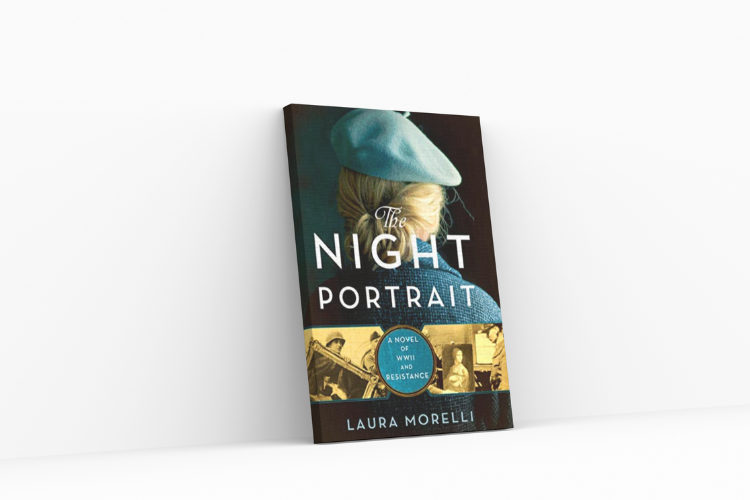
“The Night Portrait” and the Looted Art of World War II
It’s September, 1939 and Edith Becker–the protagonist of Lora Morelli’s novel The Night Portrait–sits with her hands trembling beneath the table where she’s seated before some of the most important men of the Alte Pinakoteck, one of Munich’s greatest museums.
Usually Edith’s work as a conservator keeps her well behind the scenes, but today she’s been asked to identify and comment on paintings held in private collections across Poland. What she doesn’t know is that this is just the beginning of far-reaching, highly organized plot to plunder Europe’s artwork and use it to glorify the Third Reich.
Lilith’s Fiction Editor Yona Zeldis McDonough talks to Morelli about The Night Portrait, (William Morrow, $16.99) a novel that goes back and forth through time in tracing the fraught journey of Leonardo de Vinci’s famous Lady with the Ermine, and how this priceless work of art was ultimately saved.
YZM: What inspired you to write a novel about Renaissance art looted by the Nazis?
LM: I was listening a first-hand account by Niklas Frank, the son of Nazi war criminal Hans Frank. Niklas described how Leonardo da Vinci’s Lady with an Ermine had once hung on the wall of his parents’ home in Bavaria. This idea stopped me dead in my tracks. Truth is often stranger than fiction, but how on earth did that happen, I wondered? I plunged headlong into research, retracing the incredible journey of this painting through the centuries.
What would it be like, I wondered, to be the person tasked with the job of stealing a painting by Leonardo da Vinci? The curiosity led me down rabbit hole after rabbit hole, until a story told in two timelines emerged clearly in my head. Edith and Cecilia suddenly seemed as real to me as my next-door neighbors. After that, the book seemed to write itself.
YZM: Your character Edith Becker saves works of art, not people. Does this make her a Righteous Gentile? Should we condemn her for the things she did—and the things she didn’t do—during a genocide?
LM: One of the themes of this book is the relative value of art vs. a human life. All the characters struggle with this question—especially Dominic, our fictionalized Monuments Man in the story.
Many German art professionals who were conscripted to the Nazi effort to “safeguard” works of art—functionaries like the fictional Edith Becker—quietly returned to their lives and their jobs after the war. A few of them later spoke about their attempts to assist the Resistance, either by documenting stolen works, saving convoys from bombing, or returning works to their original owners. Others undoubtedly took these secret activities to the grave.
I wondered what it must have been like to have to make these choices. Probably no one pursuing an art history career in the 1930s could have imagined themselves in such a strange and challenging position. But many early readers of The Night Portrait have told me that the story has confirmed their faith in the crucial importance of art to a culture—and the power of individual action.
YZM: Powerful men determine much about the lives of Edith and Cecilia Gallarani, yet each of these female characters manage to subvert that dynamic to suit their own needs and desires.
LM: Part of what drew me to this dual-timeline story was to realize that this portrait was an object of desire for two powerful men separated by 500 years. What was it about this woman—Cecilia Gallerani—and her likeness that was so captivating? Why did Ludovico Sforza of Milan, and later Hans Frank, Nazi-appointed governor of Poland, have to possess this picture?
Part of bringing women in historical fiction to life is to place them before realistic challenges. For a woman living at the turn of the sixteenth century, that would have meant choices about marriage, motherhood, and religious life. When Cecilia Gallerani agrees to become the mistress of a man like Ludovico Sforza, she has to own the stakes and consequences of this choice, because there’s no going back to choose something different.
During World War II, many art professionals like Edith Becker would have probably told us that they had no choice. Saying no meant risking their lives. So, how could a woman in the household of one of the most ruthless Nazi leaders have exerted some control over the situation? What was within her power to change?
YZM: Were many works of art actually restored to their rightful owners? How about art work that had belonged to Jews?
LM: The scale of the Nazi effort to confiscate works of art is simply staggering. Given that so many priceless objects were moved all over Europe as if pieces in a great chess game, it’s amazing to me that so many works went safely back to their owners after the war. In fact, it seems like a miracle! The Lady with the Ermine itself traveled so many times between 1939 and 1945. It could have been lost or destroyed so easily.
Part of the Nazi “story” was that they were safeguarding works of art so that they didn’t fall into the hands of Jewish collectors or museums. Of course, the opposite was true! Recent scholarship and individual efforts have focused on art taken from Jewish collectors during World War II, but there is still a long way to go in this area.
Of course, other works confiscated during this period went missing entirely, most famously Raphael’s Portrait of a Man. I believe that picture will reemerge one day.
Support the efforts of the Monuments Men Foundation or the German Lost Art Foundation if you want to help in restituting art that was lost or stolen during World War II.



